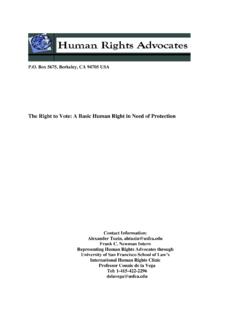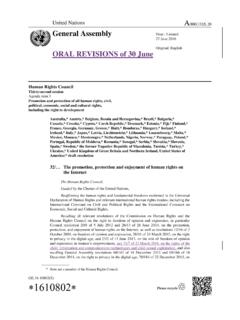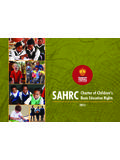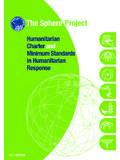Transcription of 1 HANDBOOKS RIGHT TO FOOD - Food and Agriculture ...
1 LEGISLATION. 1 RIGHT TO food . HANDBOOKS . MONITORING. The RIGHT to food within the international framework of human rights and country constitutions ASSESSMENT. BUDGET. STAKEHOLDERS. TRAINING. 1 RIGHT TO food . LEGISLATION. HANDBOOKS . The RIGHT to food within the international framework of human rights and country constitutions The content of this handbook is based on FAO's Guide on Legislating for the RIGHT to food , written by Dubravka Bojic Bultrini under the technical supervision of Margret Vidar, and with the valuable contribution of Lidija Knuth. Important contributions were likewise made by Isabella Rae. Jos Mar a Medina Rey and Maria Teresa de Febrer (PROSALUS, Spain). adapted it to the handbook format. The translation into English of this handbook was done by Stephen Carlin and Beth Gelb. The purpose of the three HANDBOOKS on LEGISLATION is to provide practical information and guidelines for national legislators and individual parties or groups interested in establishing or strengthening the legal and institutional framework surrounding the RIGHT to food , in accordance with the International Covenant on Economic, Social and Cultural rights (ICESCR) and other relevant instruments of international human rights law.
2 food and Agriculture Organization of the United Nations Rome, 2014. The designations employed and the presentation of material in this information product do not imply the expression of any opinion whatsoever on the part of the food and Agriculture Organization of the United Nations (FAO) concerning the legal or development status of any country, territory, city or area or of its authorities, or concerning the delimitation of its frontiers or boundaries. The mention of specific companies or products of manufacturers, whether or not these have been patented, does not imply that these have been endorsed or recommended by FAO in preference to others of a similar nature that are not mentioned. The views expressed in this information product are those of the author(s) and do not necessarily reflect the views or policies of FAO. FAO, 2014. FAO encourages the use, reproduction and dissemination of material in this information product.
3 Except where otherwise indicated, material may be copied, downloaded and printed for private study, research and teaching purposes, or for use in non-commercial products or services, provided that appropriate acknowledgement of FAO as the source and copyright holder is given and that FAO's endorsement of users' views, products or services is not implied in any way. All requests for translation and adaptation rights , and for resale and other commercial use rights should be made via or addressed to FAO information products are available on the FAO website ( ). and can be purchased through ii TABLE OF CONTENTS. Formulation Instruments Relationship process of the Binding with other concept of the Non-binding human rights human RIGHT and food to food and Normative content security recognition Availability of this RIGHT in Accessibility international Stability instruments Sustainability Adequacy Obligations of states Progressive adoption of measures Non-discrimination Respect, protect and fulfil INTERNATIONAL International cooperation LEVEL and assistance NATIONAL Constitutional recognition CONSEQUENCES.
4 IMPLICATIONS. LEVEL. Explicit AND. As a guiding principle Implicit Handbook 2 Handbook 3. Development through Impact of other framework laws sectoral laws The FAO glossary on the RIGHT to food is available at: 1. 1 THE RIGHT TO food UNDER INTERNATIONAL human rights LAW. BACKGROUND, BUILDING PROCESS. Within the realm of international legal instruments, human rights treaties constitute a special category characterized, among other things, by the fact that people are the rights -holders while states are the duty-bearers. The first major international example of legal thinking on human rights was the Universal Declaration of human rights passed in 1948 in the aftermath of the horrors of World War II. The Declaration recognizes the human RIGHT to food in the context of the RIGHT to an adequate standard of living. UNIVERSAL DECLARATION OF human rights , Art. 25(1): Everyone has the RIGHT to a standard of living adequate for the health and well-being of himself and of his family, including food , clothing, housing and medical care and necessary social.
5 Given that it did not have the legal status of a treaty, the Universal Declaration was subsequently implemented through two covenants that are binding on ratifying states: one for civil and political rights and the other for economic, social and cultural rights (ICESCR). The RIGHT to food is in the second category of rights . 2. BINDING AND NON-BINDING INSTRUMENTS. Binding international instruments impose legal obligations on ratifying states insofar as such states must guarantee the effective enforcement of the agreement at the national level. These international instruments take the form of treaties, covenants or conventions. MAIN BINDING INSTRUMENTS RELATED TO THE RIGHT TO FOOD1. International Covenant on Economic, Social and Cultural rights (1966). Convention on the Elimination of All Forms of Discrimination against Women (1979). Convention on the rights of the Child (1989).
6 Convention Relating to the Status of Refugees (1951). Convention on the rights of Persons with Disabilities (2006). A number of regional human rights instruments. Non-binding international instruments lay down guidelines and principles and impose moral obligations on signatory states, but the latter are not legally bound by their provisions. Nevertheless, such instruments have contributed significantly to the development of international human rights law. They take the form of declarations, recommendations or resolutions. MAIN NON-BINDING INSTRUMENTS RELATED TO THE RIGHT TO food . Universal Declaration on the Eradication of Hunger and Malnutrition (1974). Rome Declaration on World food Security (1996). Voluntary Guidelines to support the progressive realization of the RIGHT to adequate food in the context of national food security (2004). NORMATIVE CONTENT. The human RIGHT to food is addressed twice in the ICESCR: under the fundamental RIGHT to be free from hunger and under the RIGHT to adequate food .
7 1. Dates refer to the year of adoption and not of entry into force. 3. INTERNATIONAL COVENANT ON ECONOMIC, SOCIAL AND CULTURAL rights , Art. 11: 1. The States Parties to the present Covenant recognize the RIGHT of everyone to an adequate standard of living for himself and his family, including adequate food , clothing and housing, and to the continuous improvement of living conditions. The States Parties will take appropriate steps to ensure the realization of this RIGHT , recognizing to this effect the essential importance of international co-operation based on free consent. 2. The States Parties to the present Covenant, recognizing the fundamental RIGHT of everyone to be free from hunger, shall take, individually and through international cooperation, the measures, including specific programmes, which are needed: (a) To improve methods of production, conservation and distribution of food by making full use of technical and scientific knowledge, by disseminating knowledge of the principles of nutrition and by developing or reforming agrarian systems in such a way as to achieve the most efficient development and utilization of natural resources.
8 (b) Taking into account the problems of both food -importing and food -exporting countries, to ensure an equitable distribution of world food supplies in relation to need. The RIGHT to be free from hunger, closely linked to the RIGHT to life, is considered an absolute standard, the minimum level to be guaranteed to all people, regardless of the degree of development of the state in question. The RIGHT to adequate food is a much broader concept as it entails the need to establish the economic, political and social conditions necessary to enable people to achieve food security on their own. CONCEPT OF THE RIGHT TO food (GENERAL COMMENT 12). The RIGHT to adequate food is realized when every man, woman and child, alone or in community with others, has physical and economic access at all times to adequate food or means for its procurement.. The Committee considers that the core content of the RIGHT to adequate food implies: the availability of food in a quantity and quality sufficient to satisfy the dietary needs of individuals, free from adverse substances, and acceptable within a given culture.
9 The accessibility of such food in ways that are sustainable and that do not interfere with the enjoyment of other human rights . 4. COMPONENTS OF THE RIGHT TO food (CESCR General Comment 12). Availability Refers to the possibilities either for feeding oneself directly from productive land or other natural resources, or for well functioning distribution, processing and market systems that can move food from the site of production to where it is needed in response to demand. Stability It is necessary to have a stable food supply; food availability should be stable over time at all places. Accessibility All people should have access, both economic and physical, to sufficient amounts of adequate food . This implies that the costs associated with the acquisition of food for an adequate diet should be at a level such that the attainment and satisfaction of other basic needs are not compromised.
10 Sustainability Natural resources must be managed in such a way that they ensure the availability of sufficient amounts of food for both present and future generations. Adequacy food must be available in sufficient quantity to meet the nutritional needs of individuals, be free from adverse substances, and be acceptable for the culture of the group to which each person belongs. STATE OBLIGATIONS. It is primarily the duty of states to comply with human rights obligations. Regarding the RIGHT to food , we can identify several types of duties that refer to the adoption of the necessary measures for the progressive realization of this RIGHT , without discrimination, while respecting, protecting and fulfilling it, even through international cooperation and assistance. Obligation to adopt measures States must take deliberate, concrete measures aimed at achieving the full and progressive realization of the human RIGHT to food and must secure at least minimum essential levels so that people are protected from hunger.

















